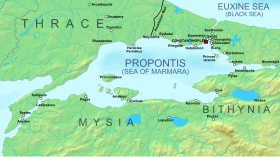Siege of Constantinople (717-718)
| Second Arab Siege of Constantinople | |||||||
|---|---|---|---|---|---|---|---|
| Part of the Arab–Byzantine wars | |||||||
 Map of the environs of Constantinople in Byzantine times |
|||||||
|
|||||||
| Belligerents | |||||||
| Umayyad Caliphate |
Byzantine Empire Bulgar Khanate |
||||||
| Commanders and leaders | |||||||
|
Maslama ibn Abd al-Malik Sulayman ibn Mu'ad Umar ibn Hubayra |
Emperor Leo III Khan Tervel |
||||||
| Strength | |||||||
| 120,000 men 2,560 ships |
unknown | ||||||
The Second Arab siege of Constantinople in 717–718 was a combined land and sea offensive by the Muslim Arabs of the Umayyad Caliphate against the capital city of the Byzantine Empire, Constantinople. The campaign marked the culmination of twenty years of attacks and progressive Arab occupation of the Byzantine borderlands, while Byzantine strength was sapped by prolonged internal turmoil. In 716, after years of preparations, the Arabs, led by Maslama ibn Abd al-Malik, invaded Byzantine Asia Minor. The Arabs initially hoped to exploit Byzantine civil strife and made common cause with the general Leo III the Isaurian, who had risen up against Emperor Theodosius III. Leo, however, tricked them and secured the Byzantine throne for himself.
After wintering in the western coastlands of Asia Minor, the Arab army crossed into Thrace in early summer 717 and built siege lines to blockade the city, which was protected by the massive Theodosian Walls. The Arab fleet, which accompanied the land army and was meant to complete the city's blockade by sea, was neutralized soon after its arrival by the Byzantine navy through the use of Greek fire. This allowed Constantinople to be resupplied by sea, while the Arab army was crippled by famine and disease during the unusually hard winter that followed. In spring 718, two Arab fleets sent as reinforcements were destroyed by the Byzantines after their Christian crews defected, and an additional army sent overland through Asia Minor was ambushed and defeated. Coupled with attacks by the Bulgars on their rear, the Arabs were forced to lift the siege on 15 August 718. On its return journey, the Arab fleet was almost completely destroyed by natural disasters and Byzantine attacks.
...
Wikipedia
